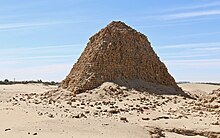Karkamani
Appearance
| Karkamani | ||||||||||||||||||||||||||
|---|---|---|---|---|---|---|---|---|---|---|---|---|---|---|---|---|---|---|---|---|---|---|---|---|---|---|
| Karkamani | ||||||||||||||||||||||||||
 Karkamani's pyramid, Nuri, Sudan | ||||||||||||||||||||||||||
| Pharaoh | ||||||||||||||||||||||||||
| Reign | c. 519–510 BC | |||||||||||||||||||||||||
| Predecessor | Amaninatakilebte | |||||||||||||||||||||||||
| Successor | Amaniastabarqa | |||||||||||||||||||||||||
| ||||||||||||||||||||||||||
| Burial | Nuri (Nu. 7) | |||||||||||||||||||||||||
Karkamani was a Meroitic king who ruled in the 6th century, probably between 519 to 510 BC at Napata. He succeeded King Amaninatakilebte and was in turn succeeded by King Amaniastabarqa.[1] Like others of his dynasty, he was discovered buried among the pyramid chambers at Nuri, specifically Nuri 7.[2]

